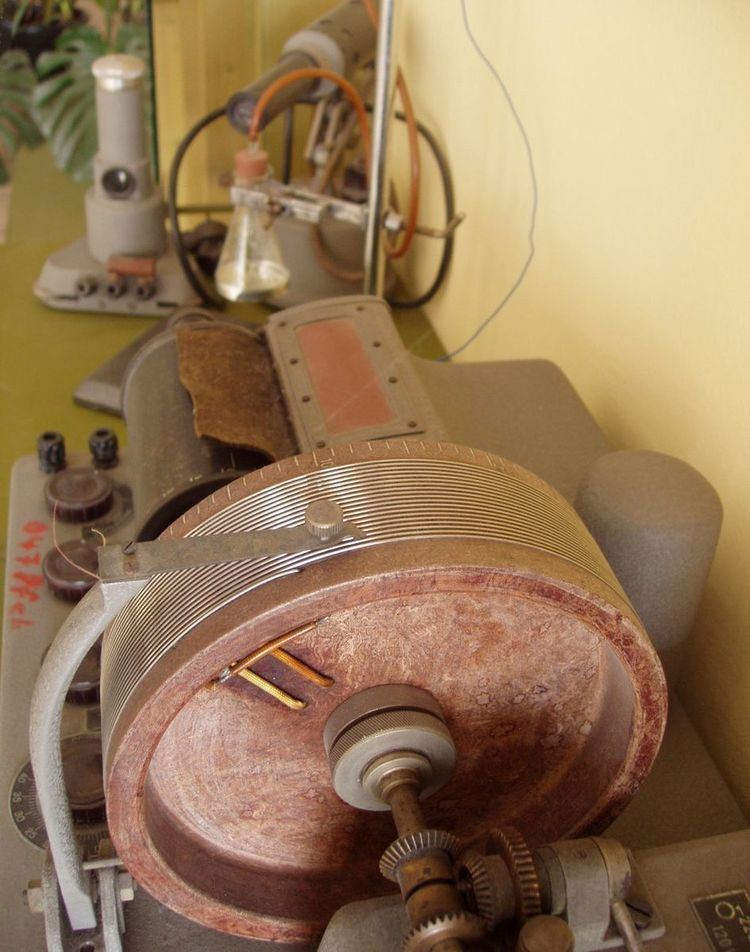 | ||
Polarography is a subclass of voltammetry where the working electrode is a dropping mercury electrode (DME) or a static mercury drop electrode (SMDE), which are useful for their wide cathodic ranges and renewable surfaces. It was invented in 1922 by Czech chemist Jaroslav Heyrovský, for which he won the Nobel prize in 1959.
Contents
Theory of Operation
Polarography is a voltammetric measurement whose response is determined by combined diffusion/convection mass transport. The simple principle of polarography is the study of solutions or of electrode processes by means of electrolysis with two electrodes, one polarizable and one unpolarizable, the former formed by mercury regularly dropping from a capillary tube. Polarography is a specific type of measurement that falls into the general category of linear-sweep voltammetry where the electrode potential is altered in a linear fashion from the initial potential to the final potential. As a linear sweep method controlled by convection/diffusion mass transport, the current vs. potential response of a polarographic experiment has the typical sigmoidal shape. What makes polarography different from other linear sweep voltammetry measurements is that polarography makes use of the dropping mercury electrode (DME) or the static mercury drop electrode.
A plot of the current vs. potential in a polarography experiment shows the current oscillations corresponding to the drops of Hg falling from the capillary. If one connected the maximum current of each drop, a sigmoidal shape would result. The limiting current (the plateau on the sigmoid), called the diffusion current because diffusion is the principal contribution to the flux of electroactive material at this point of the Hg drop life.
Limitations
There are various limitations in particular for the classical polarography experiment for quantitative analytical measurements. Because the current is continuously measured during the growth of the Hg drop, there is a substantial contribution from capacitive current. As the Hg flows from the capillary end, there is initially a large increase in the surface area. As a consequence, the initial current is dominated by capacitive effects as charging of the rapidly increasing interface occurs. Toward the end of the drop life, there is little change in the surface area which diminishes the contribution of capacitance changes to the total current. At the same time, any redox process which occurs will result in faradaic current that decays approximately as the square root of time (due to the increasing dimensions of the Nernst diffusion layer). The exponential decay of the capacitive current is much more rapid than the decay of the faradaic current; hence, the faradaic current is proportionally larger at the end of the drop life. Unfortunately, this process is complicated by the continuously changing potential that is applied to the working electrode (the Hg drop) throughout the experiment. Because the potential is changing during the drop lifetime (assuming typical experimental parameters of a 2 mV/s scan rate and a 4 s drop time, the potential can change by 8 mV from the beginning to the end of the drop), the charging of the interface (capacitive current) has a continuous contribution to the total current, even at the end of the drop when the surface area is not rapidly changing. As such, the typical signal to noise of a polarographic experiment allows detection limits of only approximately 10−5 or 10−6 M.
Improvements
Dramatically better discrimination against the capacitive current can be obtained using the tast and pulse polarographic techniques. These have been developed with introduction of analog and digital electronic potentiostats. A first major improvement is obtained, if the current is only measured at the end of each drop lifetime (tast polarography). An even greater enhancement has been the introduction of differential pulse polarography. Here, the current is measured before the beginning and before the end of short potential pulses. The latter are superimposed to the linear potential-time-function of the voltammetric scan. Typical amplitudes of these pulses range between 10 and 50 mV, whereas pulse duration is 20 to 50 ms. The difference between both current values is that taken as the analytical signal. This technique results in a 100 to 1000-fold improvement of the detection limit, because the capacitive component is effectively suppressed.
Qualitative Information
Qualitative information can also be determined from the half-wave potential of the polarogram (the current vs. potential plot in a polarographic experiment). The value of the half-wave potential is related to the standard potential for the redox reaction being studied.
This technique and especially the differential pulse anodic stripping voltammetry (DPASV) method can be used for environmental analysis, and especially for marine study for characterisation of organic matter and metals interactions.
Quantitative Information
The Ilkovic equation is a relation used in polarography relating the diffusion current (Id) and the concentration of the depolarizer (c), which is the substance reduced or oxidized at the dropping mercury electrode. The Ilkovic equation has the form:
Where k is a constant which includes π and the density of mercury, and with the Faraday constant (F) has been evaluated at 708 for max current and 607 for average current, D is the diffusion coefficient of the depolarizer in the medium (cm2/s), n is the number of electrons exchanged in the electrode reaction, m is the mass flow rate of Hg through the capillary (mg/sec), and t is the drop lifetime in seconds, and c is depolarizer concentration in mol/cm3.
The equation is named after the scientist who derived it, the Slovak chemist, Dionýz Ilkovič (1907-1980).
